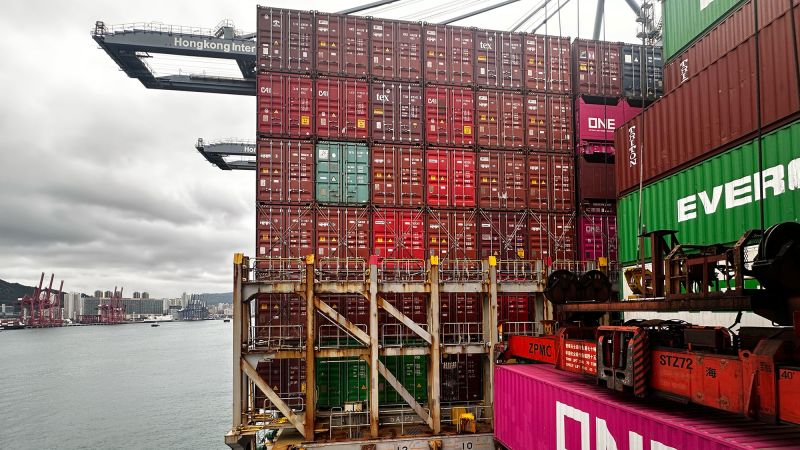US-China Trade War: The Shipping Chaos Impacting Global Supply Chains

Welcome to your ultimate source for breaking news, trending updates, and in-depth stories from around the world. Whether it's politics, technology, entertainment, sports, or lifestyle, we bring you real-time updates that keep you informed and ahead of the curve.
Our team works tirelessly to ensure you never miss a moment. From the latest developments in global events to the most talked-about topics on social media, our news platform is designed to deliver accurate and timely information, all in one place.
Stay in the know and join thousands of readers who trust us for reliable, up-to-date content. Explore our expertly curated articles and dive deeper into the stories that matter to you. Visit Best Website now and be part of the conversation. Don't miss out on the headlines that shape our world!
Table of Contents
US-China Trade War: The Shipping Chaos Impacting Global Supply Chains
The US-China trade war, while seemingly settled on the surface, continues to ripple through global supply chains, leaving a trail of shipping chaos in its wake. The initial tariffs and retaliatory measures implemented between 2018 and 2020 dramatically reshaped trade routes and logistics, creating lasting disruptions that are still felt today. This article delves into the lingering impact of this trade dispute on global shipping and the wider supply chain ecosystem.
The Initial Shockwaves: Tariffs and Trade Diversification
The imposition of tariffs on billions of dollars worth of goods significantly increased costs for businesses importing and exporting between the US and China. This led to immediate consequences:
- Increased Shipping Costs: Tariffs added directly to the price of goods, but the indirect costs were equally significant. Companies sought alternative sourcing and shipping routes, leading to increased demand and higher freight rates.
- Port Congestion: Major ports on both sides of the Pacific experienced unprecedented congestion as businesses scrambled to adjust to the new trade landscape. Delays became commonplace, further exacerbating costs.
- Supply Chain Disruptions: The unpredictable nature of the trade war forced companies to re-evaluate their entire supply chains. Many diversified their sourcing, moving production away from China to countries like Vietnam, India, and Mexico. This shift, while intended to mitigate risk, created its own set of challenges.
Lingering Effects: A New Normal for Global Shipping
While the most intense phase of the trade war has passed, its legacy continues to affect global shipping in several ways:
- Geopolitical Uncertainty: The experience highlighted the fragility of global supply chains reliant on a single major trading partner. This uncertainty continues to fuel investment in diversification and resilience-building strategies.
- Increased Transportation Costs: Although freight rates have fluctuated, they remain significantly higher than pre-trade war levels. This increased cost is passed down the supply chain, impacting consumer prices.
- Shifting Trade Dynamics: The trade war accelerated pre-existing trends towards regionalization and diversification of manufacturing and trade. This has led to the emergence of new trade hubs and altered global trade flows.
- Technological Disruptions: The need for greater supply chain visibility and resilience has driven innovation in areas such as blockchain technology and AI-powered logistics solutions.
The Future of Global Shipping: Adapting to Uncertainty
The US-China trade war served as a stark reminder of the interconnectedness of global trade and the vulnerability of supply chains to geopolitical events. Looking ahead, several key trends are shaping the future of global shipping:
- Increased focus on supply chain resilience: Businesses are prioritizing diversification, inventory management, and risk mitigation strategies to better withstand future shocks.
- Technological advancements: The adoption of digital technologies will continue to play a crucial role in improving supply chain visibility, efficiency, and resilience.
- Regionalization of trade: We can expect to see a continued shift towards regional trade blocs and closer economic cooperation within specific geographic areas.
The US-China trade war's impact on global shipping and supply chains remains profound and far-reaching. While the immediate crisis may have subsided, the long-term consequences continue to shape the landscape of international trade, demanding adaptation and innovation from businesses worldwide. Understanding these long-term effects is crucial for navigating the complexities of the global economy. Staying informed on evolving trade policies and technological advancements is essential for businesses to maintain competitiveness and resilience in this dynamic environment.

Thank you for visiting our website, your trusted source for the latest updates and in-depth coverage on US-China Trade War: The Shipping Chaos Impacting Global Supply Chains. We're committed to keeping you informed with timely and accurate information to meet your curiosity and needs.
If you have any questions, suggestions, or feedback, we'd love to hear from you. Your insights are valuable to us and help us improve to serve you better. Feel free to reach out through our contact page.
Don't forget to bookmark our website and check back regularly for the latest headlines and trending topics. See you next time, and thank you for being part of our growing community!
Featured Posts
-
 Hall Of Fame Basketball Player On Caitlin Clarks Historic Game
Jun 18, 2025
Hall Of Fame Basketball Player On Caitlin Clarks Historic Game
Jun 18, 2025 -
 Israel Vs Iran A Comparative Analysis Of Military Capabilities
Jun 18, 2025
Israel Vs Iran A Comparative Analysis Of Military Capabilities
Jun 18, 2025 -
 Report Kelsey Grammer 70 Expecting Baby Number Eight
Jun 18, 2025
Report Kelsey Grammer 70 Expecting Baby Number Eight
Jun 18, 2025 -
 Bungie Announces Indefinite Delay For Marathon
Jun 18, 2025
Bungie Announces Indefinite Delay For Marathon
Jun 18, 2025 -
 Liberty Falls To Resurgent Clark In Stunning Upset
Jun 18, 2025
Liberty Falls To Resurgent Clark In Stunning Upset
Jun 18, 2025
Latest Posts
-
 Mets Victory Over Atlanta A Turning Point In The Season
Jun 18, 2025
Mets Victory Over Atlanta A Turning Point In The Season
Jun 18, 2025 -
 Tuesday Forecast Afternoon Storms Expected
Jun 18, 2025
Tuesday Forecast Afternoon Storms Expected
Jun 18, 2025 -
 June 17 2025 Key Moments From Day 25 Of The Diddy Trial
Jun 18, 2025
June 17 2025 Key Moments From Day 25 Of The Diddy Trial
Jun 18, 2025 -
 Child Sexual Abuse Report Sidesteps Ethnicity Of Grooming Gangs
Jun 18, 2025
Child Sexual Abuse Report Sidesteps Ethnicity Of Grooming Gangs
Jun 18, 2025 -
 National Park Death Toll Rises Two Female University Students Lost
Jun 18, 2025
National Park Death Toll Rises Two Female University Students Lost
Jun 18, 2025
